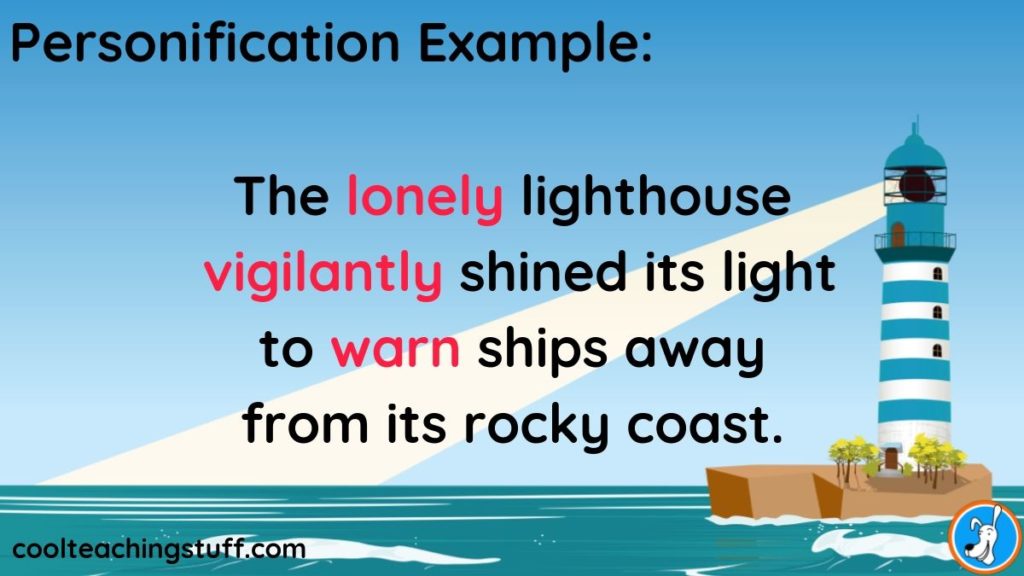What is personification?
Personification gives human qualities or characteristics to non-human animals, objects, or concepts.
(As a clue, personification has the word person in the name.)
We personify a non-human object when we humanize it through words we typically use to describe humans and human behavior.
What are some personification examples?
Here a (non-human) lighthouse is personified.

How can you recognize personification?
Let’s look at the example above.
Pay particularly close attention to the very human adjectives, adverbs, and verbs used in a description.
The lonely lighthouse vigilantly shined its light to warn ships away from its rocky coast.
- lonely (adjective) describes how a person feels.
- vigilantly (adverb) describes how a person would perform an action.
- warn (verb) describes what a person would do.
These are all words we typically use to describe people, so these descriptive words help to personify (humanize) a (non-human) lighthouse.
Why do writers use personification?
Writers use personification to connect with their audience in human terms.
Personification also helps bring writing to life.
Let’s look again at the example above. The sentence could just as easily have been written in a way that did not personify the lighthouse:
“The lighthouse shined a light that kept ships away from the rocky coast.”
Although this sentence conveys almost the same message, it is incredibly lifeless and doesn’t help the reader connect or engage with the text in nearly the same way.
What is being personified in this sentence?

What is being personified in this sentence?

What is being personified in this sentence?

What is being personified in this sentence?

What is being personified in this sentence?

What are some examples of poems with personification?
Personification is a type of figurative language as well as a literary device that’s used both in narrative text and poetry. Here are just a few personification examples used in poems.

The poem, “Fog,” by Carl Sandburg personifies fog. Although, technically, I think you could argue that it actually catifies fog. I never would have imagined fog as little cat feet sitting on its silent haunches, and yet it’s so descriptive.
By using the literary device of personification, Carl Sandburg described fog in a brand new way. He actually wrote this poem about fog in Chicago, but I think it’s the perfect poem to describe the often foggy Golden Gate Bridge in San Francisco.

In the poem, “Check,” by James Stephens, night is not only referred to with a she pronoun, but is further personified with the use of very human verbs such as creeping, crept, reached, covered, threw, stared, etc. Although a more subtle use of personification, the word night is capitalized (Night) just like the proper noun of a person’s name.
Here’s another example of personification in a poem by James Stephens. This time the moon is personified.

What is the difference between personification and anthropomorphism?
Personification and anthropomorphism are often confused, but they are not the same thing.
While personification gives human attributes to non-humans, anthropomorphism is much more literal.
Anthropomorphic characters actually talk.
Here are a few examples of the difference between personification and anthropomorphic characters.
A teapot is a non-human thing that can be personified or it can be an anthropomorphic character. It really just depends how the character is written.
Personification Example: (humanized teapot)
The teapot whistled and hissed impatiently.
Anthropomorphic Example: (talking teapot)
“I’m boiling already!” exclaimed the teapot.
Animals are very often anthropomorphic characters, but they can also be (humanized) personified.
Personification Example: (humanized hen)
The determined hen persevered to find a grain of wheat.
Anthropomorphic Example: (talking hen)
“Who will help me plant this wheat?” asked the Little Red Hen.
Personification Example: (humanized wolf)
The devious wolf loitered around the forest all afternoon.
Anthropomorphic Example: (talking wolf)
“So where are you going this afternoon, Little Red Riding Hood,” asked the Big Bad Wolf.
Think of it this way, if a non-human is actually talking, it’s anthropomorphic. Children’s picture books are loaded with anthropomorphic (talking non-human) characters such as Winnie-the-Pooh, Olivia, Pete the Cat, The Berenstain Bears, and the list goes on and on . . .
For more personification examples, check out:
Mentor Poems for Teaching Poetry

